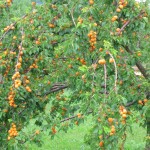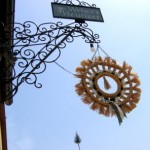Aunt Dana's Austrian Apricot Jam
 Come summer in the Wachau Valley, Austria's Napa, the apricot trees are so draped with fruit that growers have to prop up their tree limbs with wooden crutches. Orchard after orchard in this eighteen-mile stretch of land along the Danube drips with clusters of apricots - making kitchens all around the region the headquarters for edible delights of all sorts.
Come summer in the Wachau Valley, Austria's Napa, the apricot trees are so draped with fruit that growers have to prop up their tree limbs with wooden crutches. Orchard after orchard in this eighteen-mile stretch of land along the Danube drips with clusters of apricots - making kitchens all around the region the headquarters for edible delights of all sorts.
The Wachau Valley goes apricot crazy in summer, and for good reason: its apricots are prized as fruit jewels. The same climate conditions responsible for great wine - hot days and cool nights - also produce great apricots. In addition to dumplings, the apricots go into fiery local schnapps and, best of all (to my mind), homemade jam.
One summer, back in Europe for a month from our two years in Israel, my husband, Jakub, and I would drive from Prague to Mautern, in the Wachau Valley, to visit his Aunt Dana (who is Czech) and Uncle Viktor (who was Austrian). Our visits, from Friday afternoon until Saturday evening, were basically excuses for everyone to gather, eat, and drink. Late on Saturday, after wandering around Krems, the thousand year old town across the river, the four of us would usually end up with Dana and Viktor's friends at a local heuriger - family-run restaurants open in the summer. There we would eat homemade schnitzel, cheese-topped rolls, and marillenknödel (apricot dumplings dusted liberally with powdered sugar). Then we would go back to the house and sit at the garden table while the wasps zoomed overhead in the neighbor's tall apricot tree. This extraordinary tree extended into Dana and Viktor's garden by a good eight feet and obligingly dropped buckets of fruit on their side of the fence each season.
usually end up with Dana and Viktor's friends at a local heuriger - family-run restaurants open in the summer. There we would eat homemade schnitzel, cheese-topped rolls, and marillenknödel (apricot dumplings dusted liberally with powdered sugar). Then we would go back to the house and sit at the garden table while the wasps zoomed overhead in the neighbor's tall apricot tree. This extraordinary tree extended into Dana and Viktor's garden by a good eight feet and obligingly dropped buckets of fruit on their side of the fence each season.
At nightfall, Viktor would pull out bottles of Grüner Veltliner (the white wine the region is known for) from one of the local wineries he adored, Gritsch Mauritiushof or Nikolaihof. Dana would roam the garden, smoking, humming, and collecting new-fallen apricots for jam. My husband would sit and think mathematical thoughts. Viktor and I would catch each other up on book news in the U.S. and Europe - or, more accurately, Viktor (a photographer, a literature teacher, and owner of a library full of books in five languages) would talk about books and I would pretend to follow, mostly nodding happily while sipping my wine. On nights like this, it was impossible to imagine the summer ever ending or anything changing.
We'd usually haul three or four jars of the previous season's apricot jam back home to Prague, and line them up on shelf. There was nothing the jam didn't improve. We used it in vinaigrettes, spooned it into sauces of all kinds, glazed pork and chicken with it, topped yogurt with it, and (of course) added it to cakes and toasted bread with butter. Months later, on winter mornings before work, I would stand in pajamas at the kitchen counter for breakfast, look out of the window at the dark, and eat a giant spoonful of jam on a muffin. I felt like I was eating summer.
Had any of us known then that Viktor would die suddenly of liver cancer, two summers later, I think we would have sat at the garden table on those nights and gone on talking and laughing until the next evening, when it was time to leave. Indeed, it was only fitting that everyone crowded into a heurigeur after Vitkor's funeral, and ate and drank for four hours in honor of his memory.
Food and memory are intertwined for me. And Aunt Dana's apricot jam brings back to me our times in the garden with her and Viktor. I learned that while Wachau apricots have something extraordinary about them, it is the help of friends and family members while you're making the jam and canning it–and later, eating it–that is the real secret to any recipe.
 When I emailed Aunt Dana for her apricot jam recipe, she responded with an explanation that contains only the essential parts of the recipe, boiled down to a pure core. I am happy to share the recipe, and a bit of my Austrian summers, with you.
When I emailed Aunt Dana for her apricot jam recipe, she responded with an explanation that contains only the essential parts of the recipe, boiled down to a pure core. I am happy to share the recipe, and a bit of my Austrian summers, with you.
AUNT DANA'S AUSTRIAN APRICOT JAM
(Editor's note: This is a fun example of a family recipe passed down from generation to generation. While experienced canners should be able to fill in the blanks, we do not recommend that new or inexperienced canners try this recipe)
There's a special sugar here called gelierzucker, which contains a thickener. But you can use normal (granulated) sugar and just use a 1:2 or 1:3 sugar-to-fruit ratio. I recommend 1:3, so that the jam isn't too sweet.
You'll need to add pectin (or agar) and citric acid.
Dice the apricots or whiz them in a food processor, mix with sugar, and cook.
CAA Contributor Erin Ferretti Slattery is a freelance writer and jam lover. She and her husband live in New York City.
Comments (1)
1What a lovely article! I feel as if I was in the garden with you, smelling the jam. Thank you for sharing such a special memory. The recipe is reminiscent of my great grandma's ledger book of recipes!